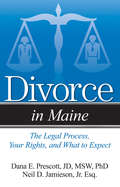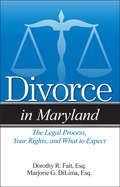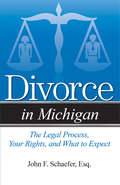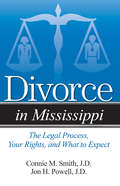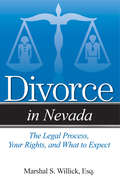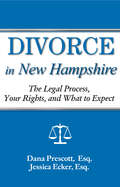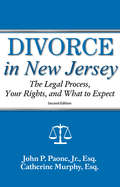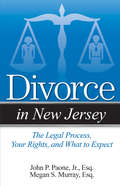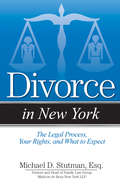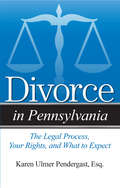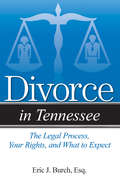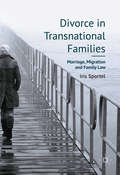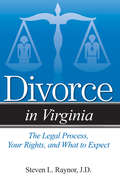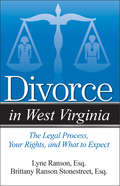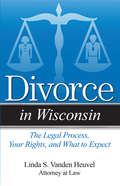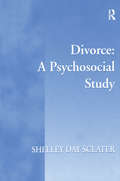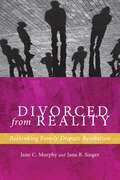- Table View
- List View
Divorce in Kansas: The Legal Process, Your Rights, and What to Expect (Divorce In)
by Stephanie Tucker Muir Scott M. Mann Scott M MannProviding accurate and objective information to help make the right decisions during a divorce in Kansas, this guide provides answers to 360 queries such as How quickly can one get a divorce? Who decides who gets the cars, the pets, and the house? What actions might influence child custody? How are bills divided and paid during the divorce? How much will a divorce cost? and Will a spouse have to pay some or all attorney fees? Structured in a question-and-answer format, this handbook provides clear responses to help build confidence and give the peace of mind needed to meet the challenges of a divorce proceeding.
Divorce in Louisiana: The Legal Process, Your Rights, and What to Expect (Divorce In)
by Betsy A. FischerProviding accurate and objective information to help make the right decisions during a divorce in Louisiana, this guide provides answers to 360 queries such as What is the mediation process in Louisiana and is it required? How quickly can one get a divorce? Who decides who gets the cars, the pets, and the house? What actions might influence child custody? How are bills divided and paid during the divorce? How much will a divorce cost? and Will a spouse have to pay some or all attorney fees? Structured in a question-and-answer format, this divorce handbook provides clear and concise responses to help build confidence and give the peace of mind needed to meet the challenges of a divorce proceeding.
Divorce in Maine: The Legal Process, Your Rights, and What to Expect (Divorce In)
by Dana E. Prescott Neil D. JamiesonProviding accurate and objective information to help make the right decisions during a divorce in Maine, this guide provides answers to 360 queries such as What is the mediation process in Maine and is it required? How quickly can one get a divorce? Who decides who gets the cars, the pets, and the house? What actions might influence child custody? How are bills divided and paid during the divorce? How much will a divorce cost? and Will a spouse have to pay some or all attorney fees? Structured in a question-and-answer format, this divorce handbook provides clear and concise responses to help build confidence and give the peace of mind needed to meet the challenges of a divorce proceeding.
Divorce in Maryland: The Legal Process, Your Rights, and What to Expect (Divorce In)
by Marjorie G DiLima Dorothy R. FaitProviding accurate and objective information to help make the right decisions during a divorce in Maryland, this guide provides answers to 350 queries such as What is the mediation process in Maine and is it required? How quickly can one get a divorce? Who decides who gets the cars, the pets, and the house? What actions might influence child custody? How are bills divided and paid during the divorce? How much will a divorce cost? and Will a spouse have to pay some or all attorney fees? Structured in a question-and-answer format, this divorce handbook provides clear and concise responses to help build confidence and give the peace of mind needed to meet the challenges of a divorce proceeding.
Divorce in Michigan: The Legal Process, Your Rights, and What to Expect (Divorce In)
by John F. SchaeferProviding accurate and objective information to help make the right decisions during a divorce in Michigan, this guide provides answers to 360 queries such as What is the mediation process in Michigan and is it required? How quickly can one get a divorce? Who decides who gets the cars, the pets, and the house? What actions might influence child custody? How are bills divided and paid during the divorce? How much will a divorce cost? and Will a spouse have to pay some or all attorney fees? Structured in a question-and-answer format, this divorce handbook provides clear and concise responses to help build confidence and give the peace of mind needed to meet the challenges of a divorce proceeding.
Divorce in Mississippi: The Legal Process, Your Rights, and What to Expect (Divorce In)
by Connie M. Smith Jon H. PowellProviding accurate and objective information to help make the right decisions during a divorce in Mississippi, this guide provides answers to 360 queries such as What is the mediation process in Mississippi and is it required? How quickly can one get a divorce? Who decides who gets the cars, the pets, and the house? What actions might influence child custody? How are bills divided and paid during the divorce? How much will a divorce cost? and Will a spouse have to pay some or all attorney fees? Structured in a question-and-answer format, this divorce handbook provides clear and concise responses to help build confidence and give the peace of mind needed to meet the challenges of a divorce proceeding.
Divorce in Nebraska: The Legal Process, Your Rights, and What to Expect (Divorce In)
by Susan Ann KoenigProviding accurate and objective information to help make the right decisions during a divorce in Nebraska, this guide provides answers to 360 queries such as What is the mediation process in Nebraska and is it required? How quickly can one get a divorce? Who decides who gets the cars, the pets, and the house? What actions might influence child custody? How are bills divided and paid during the divorce? How much will a divorce cost? and Will a spouse have to pay some or all attorney fees? Structured in a question-and-answer format, this divorce handbook provides clear and concise responses to help build confidence and give the peace of mind needed to meet the challenges of a divorce proceeding. This updated edition has been revised to include the new additions to Nebraska's divorce laws.
Divorce in Nevada: The Legal Process, Your Rights, and What to Expect (Divorce In)
by Marshal S WillickProviding accurate and objective information to help make the right decisions during a divorce in Nevada, this guide provides answers to 360 queries such as What is the mediation process in Nevada and is it required? How quickly can one get a divorce? Who decides who gets the cars, the pets, and the house? What actions might influence child custody? How are bills divided and paid during the divorce? How much will a divorce cost? and Will a spouse have to pay some or all attorney fees? Structured in a question-and-answer format, this divorce handbook provides clear and concise responses to help build confidence and give the peace of mind needed to meet the challenges of a divorce proceeding.
Divorce in New Hampshire: The Legal Process, Your Rights, and What to Expect (Divorce In)
by Dana E Prescott Jessica EckerProviding accurate and objective information to help make the right decisions during a divorce in New Hampshire, this guide provides answers to 360 queries such as: What is the mediation process in New Hampshire and is it required? How quickly can one get a divorce? Who decides who gets the cars, the pets, and the house? What actions might influence child custody? How are bills divided and paid during the divorce? How much will a divorce cost? Will a spouse have to pay some or all attorney fees? Structured in a question-and-answer format, this divorce handbook provides clear and concise responses to help build confidence and give the peace of mind needed to meet the challenges of a divorce proceeding.
Divorce in New Jersey: The Legal Process, Your Rights, and What to Expect (Divorce In)
by John P. Paone Cassie Murphy John P PaoneThis guide provides answers to 360 queries, such as: What is the mediation process in New Jersey and is it required? How quickly can one get a divorce? Who decides who gets the cars, the pets, and the house? What actions might influence child custody? How are bills divided and paid during the divorce? How much will a divorce cost? Will a spouse have to pay some or all attorney fees? Structured in a question-and-answer format, this divorce handbook provides clear and concise responses to help build confidence and give the peace of mind needed to meet the challenges of a divorce proceeding.
Divorce in New Jersey: The Legal Process, Your Rights, and What to Expect (Divorce In)
by John P. Paone Megan S. MurrayProviding accurate and objective information to help make the right decisions during a divorce in New Jersey, this guide provides answers to 360 queries such as What is the mediation process in New Jersey and is it required? How quickly can one get a divorce? Who decides who gets the cars, the pets, and the house? What actions might influence child custody? How are bills divided and paid during the divorce? How much will a divorce cost? and Will a spouse have to pay some or all attorney fees? Structured in a question-and-answer format, this divorce handbook provides clear and concise responses to help build confidence and give the peace of mind needed to meet the challenges of a divorce proceeding.
Divorce in New Mexico: The Legal Process, Your Rights, and What to Expect (Divorce In)
by Sandra Morgan Little Jan Gilman-Tepper Roberta S. Batley Tiffany Oliver LeighProviding accurate and objective information to help make the right decisions during a divorce in New Mexico, this guide provides answers to 360 queries such as What is the mediation process in New Mexico and is it required? How quickly can one get a divorce? Who decides who gets the cars, the pets, and the house? What actions might influence child custody? How are bills divided and paid during the divorce? How much will a divorce cost? and Will a spouse have to pay some or all attorney fees? Structured in a question-and-answer format, this divorce handbook provides clear and concise responses to help build confidence and give the peace of mind needed to meet the challenges of a divorce proceeding.
Divorce in New York: The Legal Process, Your Rights, and What to Expect (Divorce In)
by Michael StutmanProviding accurate and objective information to help make the right decisions during a divorce in New York, this guide provides answers to 360 queries such as What is the mediation process in New York and is it required? How quickly can one get a divorce? Who decides who gets the cars, the pets, and the house? What actions might influence child custody? How are bills divided and paid during the divorce? How much will a divorce cost? and Will a spouse have to pay some or all attorney fees? Structured in a question-and-answer format, this divorce handbook provides clear and concise responses to help build confidence and give the peace of mind needed to meet the challenges of a divorce proceeding.
Divorce in North Carolina: The Legal Process, Your Rights, And What To Expect (Divorce In)
by Eric C Trosch William C TroschProviding accurate and objective information to help make the right decisions during a divorce in North Carolina, this guide provides answers to more than 350 queries such as What is the mediation process in North Carolina and is it required? How quickly can one get a divorce? Who decides who gets the cars, the pets, and the house? What actions might influence child custody? How are bills divided and paid during the divorce? How much will a divorce cost? and Will a spouse have to pay some or all attorney fees? Structured in a question-and-answer format, this divorce handbook provides clear and concise responses to help build confidence and give the peace of mind needed to meet the challenges of a divorce proceeding.
Divorce in Oklahoma: The Legal Process, Your Rights, and What to Expect (Divorce In)
by Mark AntinoroProviding accurate and objective information to help make the right decisions during a divorce in Oklahoma, this guide provides answers to more than 350 queries such as How quickly can one get a divorce? Is it possible to get divorced if one spouse does not want a divorce? What does it mean for Oklahoma to be a community property state? Who decides who gets the cars, the pets, and the house? What factors might influence child custody? and How are bills divided and paid during the divorce? Structured in a question-and-answer format, this divorce handbook provides clear and concise responses to help build confidence and give the peace of mind needed to meet the challenges of a divorce proceeding.
Divorce in Pennsylvania: The Legal Process, Your Rights, and What to Expect (Divorce In)
by Karen Ulmer PendergastProviding accurate and objective information to help make the right decisions during a divorce in Pennsylvania, this guide provides answers to 360 queries such as: How quickly can one get a divorce? Who decides who gets the cars, the pets, and the house? What actions might influence child custody? How are bills divided and paid during the divorce? How much will a divorce cost? and Will a spouse have to pay some or all attorney fees? Structured in a question-and-answer format, this handbook provides clear responses to help build confidence and give the peace of mind needed to meet the challenges of a divorce proceeding.
Divorce in Tennessee: The Legal Process, Your Rights, and What to Expect (Divorce In)
by Eric J. BurchProviding accurate and objective information to help make the right decisions during a divorce in Tennessee, this guide provides answers to 360 queries such as What is the mediation process in Tennessee and is it required? How quickly can one get a divorce? Who decides who gets the cars, the pets, and the house? What actions might influence child custody? How are bills divided and paid during the divorce? How much will a divorce cost? and Will a spouse have to pay some or all attorney fees? Structured in a question-and-answer format, this divorce handbook provides clear and concise responses to help build confidence and give the peace of mind needed to meet the challenges of a divorce proceeding.
Divorce in Texas: The Legal Process, Your Rights, and What to Expect (Divorce In)
by Jim MuellerProviding accurate and objective information to help make the right decisions during a divorce in Texas, this guide provides answers to 360 queries such as How quickly can one get a divorce? Who decides who gets the cars, the pets, and the house? What actions might influence child custody? How are bills divided and paid during the divorce? How much will a divorce cost? and Will a spouse have to pay some or all attorney fees? Structured in a question-and-answer format, this divorce handbook provides clear responses to help build confidence and give the peace of mind needed to meet the challenges of a divorce proceeding.
Divorce in Transnational Families
by Iris SportelThis book uniquely focuses on the role of family law in transnational marriages. The author demonstrates how family law is of critical importance in understanding transnational family life. Based on extensive field research in Morocco, Egypt and the Netherlands, the book examines how, during marriage and divorce, transnational families deal with the interactions of two different legal systems. Sportel studies the interactions of European and Islamic family law, addressing its interconnections with migration and everyday life, within the context of highly politicised debates on gender, Islam, migration and the family. The book will be of interest to scholars and students of family sociology, migration and diaspora studies, transnational families, family law, and sociology of law.
Divorce in Virginia: The Legal Process, Your Rights, and What to Expect (Divorce In)
by Steven L. RaynorProviding accurate and objective information to help make the right decisions during a divorce in Virginia, this guide provides answers to 360 queries such as What is the mediation process in Virginia and is it required? How quickly can one get a divorce? Who decides who gets the cars, the pets, and the house? What actions might influence child custody? How are bills divided and paid during the divorce? How much will a divorce cost? and Will a spouse have to pay some or all attorney fees? Structured in a question-and-answer format, this divorce handbook provides clear and concise responses to help build confidence and give the peace of mind needed to meet the challenges of a divorce proceeding.
Divorce in Washington: The Legal Process, Your Rights, and What to Expect (Divorce In)
by David J. CrouseProviding accurate and objective information to help make the right decisions during a divorce in Washington, this guide provides answers to 360 queries such as What is the mediation process in Washington and is it required? How quickly can one get a divorce? Who decides who gets the cars, the pets, and the house? What actions might influence child custody? How are bills divided and paid during the divorce? How much will a divorce cost? and Will a spouse have to pay some or all attorney fees? Structured in a question-and-answer format, this divorce handbook provides clear and concise responses to help build confidence and give the peace of mind needed to meet the challenges of a divorce proceeding.
Divorce in West Virginia: The Legal Process, Your Rights, and What to Expect (Divorce In)
by Lyne Ranson Brittany Ranson StonestreetProviding accurate and objective information to help make the right decisions during a divorce in West Virginia, this guide provides answers to more than 350 queries such as How quickly can one get a divorce? Is it possible to get divorced if one spouse does not want a divorce? What does it mean for West Virginia to be a community property state? Who decides who gets the cars, the pets, and the house? What factors might influence child custody? and How are bills divided and paid during the divorce? Structured in a question-and-answer format, this divorce handbook provides clear and concise responses to help build confidence and give the peace of mind needed to meet the challenges of a divorce proceeding.
Divorce in Wisconsin: The Legal Process, Your Rights, and What to Expect (Divorce In)
by Linda S. Vanden HeuvelProviding accurate and objective information to help make the right decisions during a divorce in Wisconsin, this guide provides answers to 360 queries such as What is the mediation process in Wisconsin and is it required? How quickly can one get a divorce? Who decides who gets the cars, the pets, and the house? What actions might influence child custody? How are bills divided and paid during the divorce? How much will a divorce cost? and Will a spouse have to pay some or all attorney fees? Structured in a question-and-answer format, this divorce handbook provides clear and concise responses to help build confidence and give the peace of mind needed to meet the challenges of a divorce proceeding in the state of Wisconsin.
Divorce: A Psychosocial Study
by Shelley Day SclaterSeveral jurisdictions have attempted to render divorce more harmonious by abolishing matrimonial 'fault' and facilitating the resolution of divorce disputes by mediation. In Britain, these provisions appear in the Family Law Act 1996. The book presents a challenge to the underlying assumptions that conflict and the adversarial system are undesirable. Its focus is on adults’ experiences of divorce. In a series of interviews, divorcing people told their own stories of divorce. The personal narratives revealed that divorce can be emotionally traumatic, but it has positive sides too. The emotions of divorce are not pathological , but are readily explicable as ordinary human coping strategies , in the context of the real material privations that many divorcing people suffer. These coping strategies often involve conflict and acrimony. From a psychodynamic perspective, it is argued that these are integral, and psychologically necessary, aspects of the divorce process. This book is particularly topical in the light of the recent decision of the British Government to postpone the implementation of the Family Law Act 1996 and the acknowledged need for research to inform policy.
Divorced from Reality: Rethinking Family Dispute Resolution (Families, Law, and Society #5)
by Jana B. Singer Jane C. MurphyOver the past thirty years, there has been a dramatic shift in the way the legal system approaches and resolves family disputes. Traditionally, family law dispute resolution was based on an "adversary" system: two parties and their advocates stood before a judge who determined which party was at fault in a divorce and who would be awarded the rights in a custody dispute. Now, many family courts are opting for a "problem-solving" model in which courts attempt to resolve both legal and non-legal issues. At the same time, American families have changed dramatically. Divorce rates have leveled off and begun to drop, while the number of children born and raised outside of marriage has increased sharply. Fathers are more likely to seek an active role in their children's lives. While this enhanced paternal involvement benefits children, it also increases the likelihood of disputes between parents. As a result, the families who seek legal dispute resolution have become more diverse and their legal situations more complex. In Divorced from Reality, Jane C. Murphy and Jana B. Singer argue that the current "problem solving" model fails to address the realities of today's families. The authors suggest that while today's dispute resolution regime may represent an improvement over its more adversary predecessor, it is built largely around the model of a divorcing nuclear family with lawyers representing all parties--a model that fits poorly with the realities of today's disputing families. To serve the families it is meant to help, the legal system must adapt and reshape itself.


